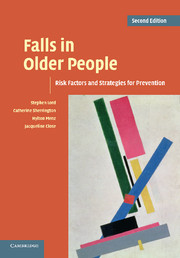Book contents
- Frontmatter
- Contents
- Preface
- Acknowledgements
- Part I Epidemiology and risk factors for falls
- Part II Strategies for prevention
- 10 Exercise interventions to prevent falls
- 11 Exercise interventions to improve physical functioning
- 12 Medical management of older people at risk of falls
- 13 Assistive devices and falls prevention
- 14 Modifying the environment to prevent falls
- 15 Prevention of falls in hospitals and residential aged care facilities
- 16 A physiological profile approach to falls risk assessment and prevention
- 17 Research into practice
- Part III Research issues in falls prevention
- Index
- References
16 - A physiological profile approach to falls risk assessment and prevention
Published online by Cambridge University Press: 03 May 2010
- Frontmatter
- Contents
- Preface
- Acknowledgements
- Part I Epidemiology and risk factors for falls
- Part II Strategies for prevention
- 10 Exercise interventions to prevent falls
- 11 Exercise interventions to improve physical functioning
- 12 Medical management of older people at risk of falls
- 13 Assistive devices and falls prevention
- 14 Modifying the environment to prevent falls
- 15 Prevention of falls in hospitals and residential aged care facilities
- 16 A physiological profile approach to falls risk assessment and prevention
- 17 Research into practice
- Part III Research issues in falls prevention
- Index
- References
Summary
As outlined in Chapter 6, research studies have identified a broad range of medical conditions which contribute to falls risk. These include chronic and degenerative diseases, such as stroke, Parkinson's disease, arthritis, foot problems, cognitive impairment peripheral neuropathy and diabetes cataracts and vestibular disorders. However, attributing a degree of falls risk to a specific medical diagnosis is often problematic because the severity of these conditions varies considerably among individuals. Furthermore, impairments in sensorimotor function and balance associated with increased age, inactivity, medication use or minor pathology, may be evident in older people without diagnosed medical conditions.
To address this issue, we have devised a Physiological Profile Assessment (PPA) for assessing falls risk that involves quantitative assessment of sensorimotor and balance abilities. Physiological factors that are the important contributors to stability are shown in Figure 16.1. Functioning in each of these factors declines with age and impairments in each factor increases the risk of falling. A marked deficit in any one of these factors may be sufficient to predispose an older person to fall; however, a combination of mild or moderate impairments across physiological domains also may increase the risk of falling. By assessing an individual's physiological abilities, impairments in one or more physiological domains can be identified and cumulative falls risk can be determined.
- Type
- Chapter
- Information
- Falls in Older PeopleRisk Factors and Strategies for Prevention, pp. 333 - 356Publisher: Cambridge University PressPrint publication year: 2007
References
- 45
- Cited by

